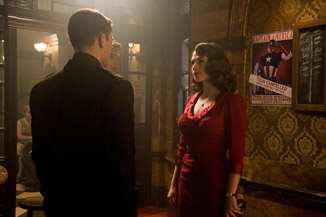|
|
(Comic) Book vs. MovieCaptain AmericaBy Russ BickerstaffJuly 28, 2011
Occasionally, tiny bits of personality do filter through the story. Most notably, there was kind of a chilling scene at the end of the first Red Skull story in which the Skull accidentally rolls over a hypodermic of poison in a tussle with Bucky as Cap looks on. After the Red Skull dies, Bucky asks Captain America, “…you saw it all - why didn’t you stop him from killing himself?” To which Cap replies, “I’m not talking, Bucky!” And it's never brought-up again. The US could have presumably learned a lot from a US-based Nazi super-spy and Captain America let him die - presumably out of spite. It’s an uncharacteristically dark moment in an otherwise cheerily grandiose action/espionage series. (Red Skull, of course, returns a couple of issues later having survived the poison.) The Movie Whereas the original comic book was created and produced by people with a great deal of interest in US foreign policy, the producers of the current film version aren’t all that interested in current events. The idea here is to make money to expand business for Marvel Productions’ growing line of superhero films. A single piece in a highly ambitious, highly interconnected series of big-budget action films, Captain America: The First Avenger is more interested in telling a good story than influencing public opinion.
[ View other columns by Russ Bickerstaff ]
[ View other Book vs. Movie columns ]
[ Email this column ]
|

|
|
|

|
Friday, November 1, 2024
© 2024 Box Office Prophets, a division of One Of Us, Inc.


